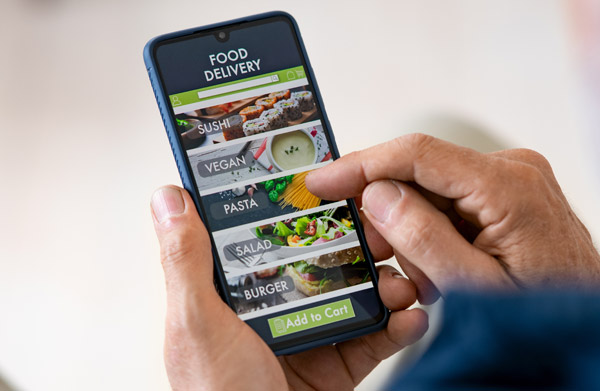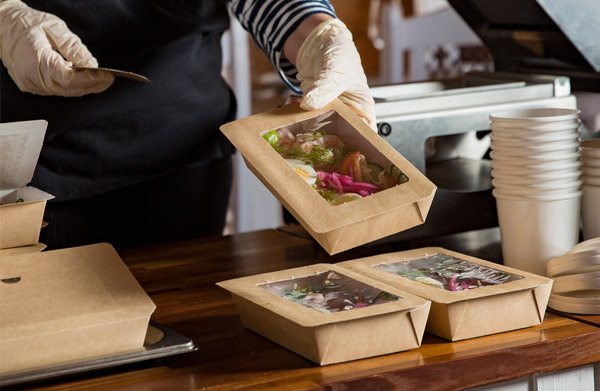With the onset of Covid-19 drastically changing the landscape of the restaurant business, to survive restaurants have had to beef up their curb-side pickup and delivery offerings. As a result, it became necessary to develop relationships with third party deliver platforms such as Uber Eats and DoorDash. These delivery apps can successfully open up your restaurant’s offerings to a large audience and help drive consistent revenue, but their double-digit commissions can cut into your bottom line.
The Virtual Restaurant Brand

To open up their restaurant’s offering to new audiences, many ambitious restaurants have created virtual brands on third party delivery platforms. These virtual brands promote items that are already featured on the restaurant’s existing menu but are branded under a new virtual entity that is more focused on a specific market segment.
Some of the more high-profile examples of these virtual brands offered on delivery apps are “Cosmic Wings”, a virtual brand launched by Applebees to focus on it’s wings menu. Denny’s has also launched the virtual brands “The Burger Den” and “The Melt Down. “Just Wings” is the virtual brand launched by Chilis and is anticipated to bring in $150 million in annual sales. Also there are the virtual brands launched by Smokey bones called “The Wing Experience” and “The Burger Experience”.
All of these brands have had a high level of success and have increased each restaurants revenue on the food delivery platforms. Most importantly, each one of these virtual brands were created to focus on a particular area that the restaurants already had a high level of culinary success, so speed to market was relatively quick and smooth. The end result is that through these virtual brands, brick and mortar restaurants are finding ways to attract new customers to try their existing menu items, but under a new brand that tightly focuses on particular food channels.
The Challenge of Marketing a Virtual Restaurant Brand

One of the biggest challenges to overcome when launching a virtual brand on a restaurant delivery platform is that your brand’s exposure is greatly dependent on how it is featured on the delivery app. Bringing awareness to your brand can take a significant investment. A restaurant has to consider how they can best leverage the third-party marketing space and to drive business and create a great user experience.
Though your restaurants marketing on third-party apps is limited to food photography, menu descriptions, and pricing and deal information, apps such as Uber Eats and DoorDash to offer restaurant marketers access to consumer data that they don’t otherwise have. Taking advantage of this valuable data is key, as it provides great intel on your delivery customers that you can leverage.
A great tactic for taking advantage of this data to use traditional marketing tactics such as a restaurant direct mail promotion that is mailed within the deliver radius. The mail piece can provide valuable exposure and awareness for your virtual brand. Included in the direct mail piece could be messaging about your core offerings and a call-to-action that drives customers to your order. Including a QR code will enable the customer to go directly to your brand’s page on the delivery app is also great to include.
Direct Mail Postcards have always been one of the best restaurant marketing tools to drive in new business, create awareness, and increase profits. Promoting virtual brands that expand your restaurant’s market share on third-party delivery apps is just another example of how this time-tested traditional marketing tactic can help your restaurant business grow.
Virtual Restaurant FAQ
A virtual restaurant brand is a restaurant concept that operates exclusively online. Instead of having a physical location, the restaurant instead operates as an online platform where customers can order food for delivery or takeout. The concept is becoming increasingly popular as more and more people turn to online delivery services for their meals. A virtual restaurant brand typically has its own unique menu and branding, but it can also partner with existing restaurants to provide its customers with additional options. By focusing solely on online orders and delivery, virtual restaurant brands can offer affordable delivery options, faster service times, and more convenient ordering options than traditional restaurants.
Restaurant delivery apps are mobile applications that allow users to order food from their favorite restaurants and have it delivered to their home or office. These apps typically offer a wide variety of restaurant options from local favorites to popular chain restaurants. Most apps provide an easy-to-use interface where users can browse menus, place orders, track orders, and pay for meals. Additionally, many apps offer loyalty programs, discounts, and other incentives to encourage customers to use them. For restaurant owners, these apps provide a convenient way to reach more customers and increase sales. And for diners, they offer a convenient way to enjoy their favorite meals without having to leave their homes.
Promoting a virtual restaurant brand can be challenging, but it is possible with the right strategy. The first step is to create a strong online presence. This includes having an up-to-date website with recent menu items and images and a strong presence on social media channels like Facebook, Instagram, and Twitter. You should also consider running targeted ad campaigns on these channels to reach new customers. Additionally, you can reach out to local news outlets and bloggers to get the word out about your virtual restaurant brand.
You can also utilize strategies beyond the digital world. Consider partnering with other local businesses to reach their customers or sponsoring local events or charities. You can also look into setting up a physical location for customers to pick up orders or even create a mobile ordering experience. Whatever approach you take, the key is to be creative and think outside the box when it comes to promoting your virtual restaurant brand.
Combining direct mail and digital ads is a great way to promote a virtual restaurant brand. Direct mail gives you the opportunity to reach potential customers in a more personalized way, while digital ads can help you reach a wider audience. By using both channels, you can ensure that your message is seen by as many people as possible. You can also use the data from digital ads to retarget customers who have already expressed an interest in your brand. Additionally, direct mail has the potential to drive additional online traffic to your website or social media page, which could help you build a more engaged audience. Ultimately, combining direct mail and digital ads can be an effective way to reach a wide range of potential customers and build a successful virtual restaurant brand.


